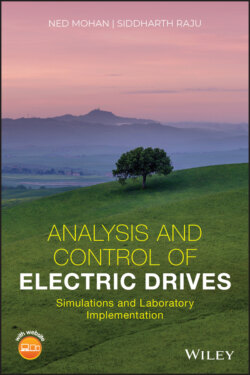Читать книгу Analysis and Control of Electric Drives - Ned Mohan - Страница 42
Solution
ОглавлениеIn the plot of Fig. 2-2b, the magnitude of the acceleration and the deceleration is 100 rad/s2. During the intervals of acceleration and deceleration, since TL = 0,
as shown in Fig. 2-8.
During intervals with a constant speed, no torque is required. Since the position θ is the time‐integral of speed, the resulting change of position (assuming that the initial position is zero) is also plotted in Fig. 2-8.
Fig. 2-8 Speed, torque, and angle variations with time.
In a rotational system shown in Fig. 2-9, if a net torque T causes the cylinder to rotate by a differential angle dθ, the differential work done is
(2-26)
Fig. 2-9 Torque, work, and power.
If this differential rotation takes place in a differential time dt, the power can be expressed as
(2-27)
where ωm = dθ/dt is the angular speed of rotation. Substituting for T from Eq. (2-21) into Eq. (2-27),
(2-28)
Integrating both sides of Eq. (2-28) with respect to time, assuming that the speed ωm and the kinetic energy W at the time t = 0 are both zero, the kinetic energy stored in the rotating mass of inertia J is
(2-29)
This stored kinetic energy can be recovered by making the power p(t) reverse direction, that is, by making p(t) negative.
